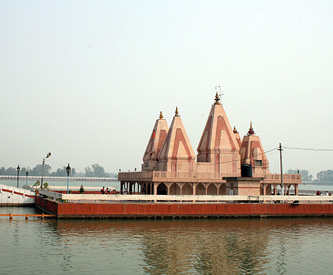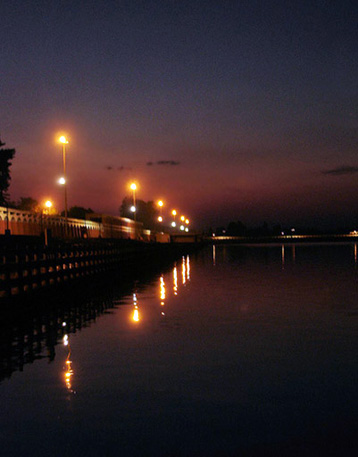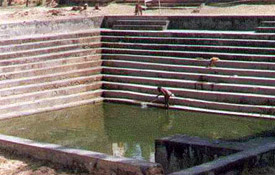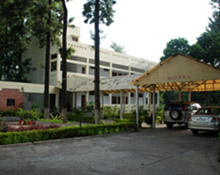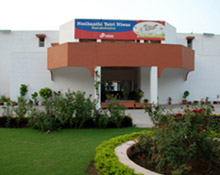| Kurukshetra |
Location: Kurukshetra town lies in Haryana state and is about 160 KM North of Delhi, 39 Km North of Karnal and 40 Km South of Ambala, at a distance of 6 Km from Pipli an important road junction on the National Highway no 1 popularly known as Grant Trunk Road. This District lies between Latitude 29*-52’ to 30*-12’ and longitude 76*-26’ to 77*-04’ in the Northern Eastern Part of Haryana state.
Historical and Pilgrimage centre
It is a district in Haryana state of India. Known as a holy place; Kurukshetra earns its name from King Kuru, the ancestor of Kauravas and Pandavas. What makes it really important is the theory that this was where the Kurukshetra war of the Mahabharata was fought and the Bhagavad Gita emerged during the war when Lord Krishna found Arjuna in a terrible dilemma.. Rashtrakavi Ramdhari Singh 'Dinkar' has written an epic poem by the title of Kurukshetra. It is a narrative poem based on the Santi Parva of the Mahabharata. It was written at a time when the memories of the Second World War were fresh on the mind of the poet. |
|
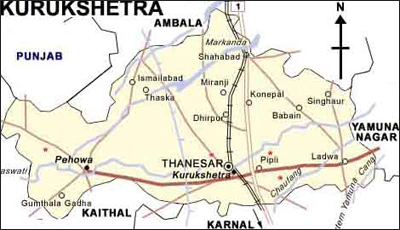 |
|
| |
Thanesar or Sthaneswar, a historical town is located adjacent to what is now newly created Kurukshetra city. Thanesar derives its name from the word "Sthaneshwar" which means "Deity of the Place". The Sthaneshwar Mahadev Temple, whose presiding deity is Lord Shiva, is believed to be the oldest temple in the vicinity. Local hearsay identifies the legendary "Kurukshetra" with a nearby obscure hamlet, and with the active abetment of the state government, it is presently experiencing a tourist boom [citation needed].
A few kilometeres from Kurukshetra is the village known as "Amin", where there are remnants of a fort and it is said to be Abhimanyu's fort.
In some ancient Hindu texts, the boundaries of Kurukshetra correspond roughly to the state of Haryana. Thus according to the Taittiriya Aranyaka 5.1.1., the Kurukshetra region is south of Turghna (Srughna/Sugh in Sirhind, Punjab), north of Khandava (Delhi and Mewat region), east of Maru (=desert) and west of Parin.
It is written in Puranas that Kurukshetra is named after the King Kuru of Bharata Dynasty,ancestor of Pandavas and Kauravas. In Vaman purana it has been elaborated that King Kuru came to settle on this land. He chose this land at the banks of Sarasvati River for imbedding spirituality with 8 virtues- austerity (tapas), truth (satya), forgiveness (kshama), kindness (daya), purity (sucha), charity (dana), yagya and brahmacharya.Lord Vishnu was impressed with the act of King Kuru and blessed him. God gave him two boons, one that this land forever will be known as a Holy Land after his name as Kurukshetra(the land of kuru) and the other that anyone dying on this land will be going to heaven. The land of Kurukshetra was separated between two rivers — the Sarasvati and the Drishadvati. This land has been known as Uttravedi, Brahmavedi, Dharamkshetra and Kurukshetra at different periods. When King Kuru came on this land it was called Uttarvedi. Over the period this land has been ruled by many empires.Bharata Dynasty came and settled on this land. Later Battle of Mahabharata was fought on this land during which Lord Krishna preached Bhagavad Gita to Arjuna. It reached zenith of progress during the reign of King Harsha during the period of which Chinese scholar Hieun Tsang visited this land at Thanesar. By the archaeological grounds it has been proved that Ashoka the Great made Kurukshetra a centre of learning for people from all over the world.Mughals also ruled this land. Sufi saint Sheikh Chehli's tomb on this land is an evidence of this fact.
Kurukshetra was earlier a sub division of Distt Karnal in Panjab before creation of Haryana out of joint Panjab in 1966. It was made a District in 1973 with Distt H Q at Kurukshetra.The total area of Kurukshetra district is 1,68253 hectares and has a population of 8,25,454. The Population of Kurukshetra is 6.41 Lakhs which used to be less than a lakh in sixties. The Distt has 419 villages. Three rivers viz. Markanda, Ghaggar and Saraswati flow through this district.
It is one of the Agriculturally prosperous Distt of the state with wheat and Sugarcane being the main crops.
It used to be a very small town before reorganisation of Panjab and creation of Haryana in 1966. Keeping its importance and cultural traditions Kurukshetra has now developed in to a modern city having Kurukshetra University, Regional Engg College, (Now NIT ), Ayurvedic Medical College, Science Museum, and a number of Computer training institutes etc.
Climate: Climate of Kurukshetra is very hot in summer up to 47* and very cold in winter (down to 1*) with rains in June to August . |
| |
| Places of interest |
 |
Brahma Sarovar: Every year lakhs of people come to take holy bath at Brahma Sarovar on the occasion of "Somavati Amavasya" (Sacred No-Moon Day that happens on a Monday) |
 |
Sannihit Sarovar |
 |
Krishna Museum: Have some historical artifacts, paintings depicting Mahabharata war |
 |
Kurukshetra Panorama and Science centre: An excellent world class Panorama depicting the Mahabharata war with scientific explanations justifying every episode in the war. There are also several scientific exhibits which kindle in the visitor, a curiosity for science |
 |
Kalpana Chawla Planetarium |
 |
Light and Sound Show: A newly built Tourist attraction which highlights some aspects of Geeta Saar in brillaint combination of lights and sound. |
 |
Dharohar: A must visit to know the Tradition and Culture of Haryana located in Kurukshetra University. |
 |
Bhishma Kund at Naraktari: The place where Arjun shot an arrow towards earth to quench Bhisma Pitamah thirst |
 |
Saraswati Forest Reserve: It is a large reserved forest area with rich flora and fauna in Kurukshetra district |
 |
Sheikh Chehli ka makbara (tomb): This monument is maintained by ASI. It's a nice and well maintained monument which was built during Mughal period in remembrance of Sufi Saint Sheikh Chehli, believed to be spiritual teacher of Mughal Prince, Dara Shikoh |
 |
Sthaneshwar Mahadev |
 |
Kamal Nabhi |
 |
Bhadrakali Mandir |
 |
Birla Mandir |
 |
Gurdwara Raj Ghat Patshahi Dasvin |
 |
Gurdwara Chhevin Patshahi |
 |
Gurdwara Siddh Bati Patshahi Pahili |
 |
Ban Ganga |
 |
Kurukshetra University |
 |
National Institute Of Tecknology (Deemed University) |
|
| |
| How to reach |
By Air
The Airports close to Kurukshetra are at Delhi and Chandigarh, which are well connected by road and rail. Taxi service is also available.
By Train
Kurukshetra is a railway junction located on the main Delhi Ambala Railway line, well connected with all important towns and cities of the country. The Shatabadi Express halts here.
By Road
There are two Bus Stands in Kurukshetra.One at Pipli which is on National Highway and easily accessible for the visitors coming from all over the corners of the world.Another Bus stand is at Kurukshetra.Buses of Haryana Roadways and other State Corporations ply through Kurukshetra and connect it to Delhi, Chandigarh and other important places. |
|
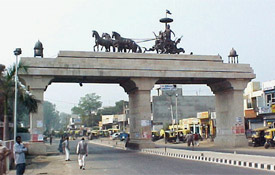 |
Dwar to Kurukshetra at Pipli junction
at National highway |
|
|
| |
| Kurukshetra University |
The Kurukshetra University was established in 1956 and its foundation stone was laid by late Dr. Rajendra Prasad, President of India. KU located in the holy city of Kurukshetra. A multi-faculty University as one of the premier centers for advanced study and research in the region. In KU Faculties of Arts & Languages, Social Sciences, Indic Studies, Science, Law, Education, Commerce & Management, Engg. & Technology, Medical & Dental Sciences and Ayurveda are available. Some of the professional job-oriented courses available for regular students in the Teaching Departments include: MBA, MIB, MFC, MMT, MCA, M.Sc., (Computer Science Software), Home Science, Information Technology, M. Tech. (Computer Sc. & Engg.), Master of Tourism Management, MBE, M.P.Ed., M.Com., M.A. Mass Communication, B.Lib. & Inf. Sc., M.Lib. & Inf. Sc., MBA-5 year, LL.B.-5 year, LL.B.-3 year, LL.M., M.Sc. Bio-technology / Microbiology / Bio-Chemistry / Electronics / Industrial Chemistry-Pharmaceutical Science, B.Pharma, B.Tech. Instrumentation, etc. |
|
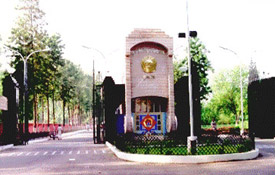 |
|
| |
Apart from Master's degree courses, research facilities are also available in the University for M.Phil. and Ph.D. The sprawling campus of the University is self-contained. Set in a salubrious, natural landscape, it has in its range a Science and Instrumentation Centre; well equipped Health Centre; Employment, Information and Guidance Bureau; Computer Centre; Students' Centre; Community Centre; Faculty Lounge; Teachers' Club; residential complex and 16 hostels for boys and girls including two Youth Hostels with all modern amenities. The campus has its own sports complex comprising extensive play-fields, Stadium, Gymnasium, a Swimming Pool, Yoga Centre, etc. as also a magnificent air-conditioned Auditorium with a seating capacity of over 2500. Apart from Departmental Libraries, the students have access to the centrally air-conditioned University Library which is one of the best libraries, connected with ernet facility, harbouring in the region. The University has also been accredited by the National Assessment & Accreditation Council. |
| |
| Brahma Sarovar |
|
| |
Among the holiest of water tanks in India, the Brahma Sarovar is an important place to visit in Kurukshetra. This is a vast water body. In the centre of the tank stands the Sarveshwar Mahadev Temple looking like a lotus. The eastern section of the tank is 1800 ft long and 1500 ft wide while the western section is a square of 1500 ft length and 1500 ft breadth. The tank is 15 ft deep. This large water body is edged with 20 ft wide platforms, stairs and a 40 ft wide 'parikarma'.
In this section, a number of meditation chambers have been built for the convenience of pilgrims. It Is believed that it is the cradle of Indian civilization because Lord Brahma, the Creator of the Universe, conceived the Earth here. A dip in the Sarovar bears the sanctity of performing Ashwamedha Yajna, which, the scriptures say, absolves one of all the sins. The |
|
|
|
|
months of November and December are the time when migratory birds flock around Brahma Sarovar and add an exhilarating environmental setting to the sanctity of the place. |
| |
The tank lies about 3 km from the railway station. A number of temples lie in close vicinity of this holy water body, of which the prominent one is the Lakshmi Narayan Temple. This temple lies opposite the Brahma Sarover. It is dedicated to Lord Narayan and His consort Lakshmi. The architecture of the temple belongs to the late 18th century, which adds a touch of history to the visit. The temple's tall pinnacle proclaims its presence from a distance. |
| |
| Panorama and Sri Krishna Museum |
A touch of history and archaeolgy of the area can be seen at the Panorama project and the Sri Krishna Museum setup near the Brahma Sarover.
Situated near Brahma Sarovar and set up by the Kurukshetra Development Board, it is one of the finest museums on the theme of Krishna . It has a collection of wide variety of beautiful sculptures, paintings and other artistic creations relating to the legend of Krishna .The Sri Krishna Museum comprises of six galleries in which a variety of art objects such as wood carvings, metal castings, ivory carvings, miniature paintings, palm leaf etches, illustrated manuscripts, tableaux depicting facets of life and exploits of Sri Krishna have been displayed.Paintings of the Kangra and Madhubani styles, pattachitra-folk paintings of Orissa depicting scenes from Mahabharata have been prominently displayed.At the entrance of the Sri Krishna Museum , visitors are greeted by splendid sculpture of Ganesh in a dancing mudra (posture). |
|
 |
|
| |
| Sannihit Sarovar |
Sannihit Sarovar is yet another sacred water tank. Legend has it that hundreds of years ago people, burdened by their sins, sought help from the Lord. At this, the Lord said 'On the days of Amavasyas (nights of total darkness) or on the days of an eclipse, if you collect the water of Sannihit tank, your sins will be absolved.' Ever since, the tank has been the venue of millions of devotees who perform the Ashwamedha Yajna. The Kumbh Mela is yet another major event related to the legendary Sannihit Sarovar.
The sarover spreads 1500 ft in length and 550 ft in breadth. Bathing ghats and steps have been set up here for pilgrims. Temples dedicated to Dhruva Narayan, Mother Goddess Durga and Lord Hanuman can be seen here. It lies about 1 km from the Brahma Sarover. |
|
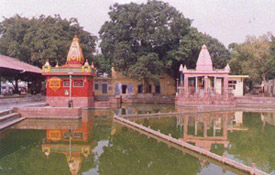 |
|
| |
| Gurdwaras |
A few gurdwaras at Kurukshetra have acquired great sanctity and have become places of pilgrimage. The site where Guru Nanak stayed is now worshipped as Gurdwara Sadbhiti. Another gurdwara stands besides it where the sixth Guru Har Gobind stayed during a visit. Again, the ninth Guru, Shri Tegh Bahadur stayed at a spot near the Sthaneshwar Tirtha that is marked by a gurdwara. Another prominent gurdwara called Raj Ghat is devoted to the memory of the tenth Guru, Gobind Singh. |
| |
Places of Interest around Kurukshetra |
| Thanesar |
Thanesar is one of the most sacred places of Hindu pilgrimage. The town derives its name from the words Sthan-esvar or the abode of God (Mahadev). The town was once the centre of great learning. Today it is famous for the Sthanesvar Mahadev temple and the Ma Bhadra Kali Temple. It lies adjoining the town of Kurukshetra and is often called its twin town. It is a sacred town for Hindus because the Shiva in the form of linga (organ) was first worshipped here. Kuru, the Kauravas and Pandavas' ancestors meditated on the banks of the Yamuna and Parasurama killed many Kshatriyas here. King Harsha was born here, ascended the throne at the age of 16 and ruled for 41 years, sharing his seat of power with his widowed sister whom he had rescued from Sati (self-immolation). During his rule, the renowned Chinese traveler Huen Tsang lived in Thanesar for a number of years and Bana Bhatt, the celebrated Sanskrit scholar, met Harsha here.
It can be said without a doubt that the presiding deity of Thanesar is Lord Shiva. It is after the Sthanesvar Shiva Linga Temple that Thanesar gets its name. Vaman Puran categorically mentions the importance of this temple and legends tell us that Lord Brahma Himself laid the first Linga of Lord Shiva at the temple. Renovated in recent times, the temple has a white amla (fruit shaped) dome. A large water body has been designed before the temple. A Gurudwara that lies opposite the Sthanesvar temple marks the spot sanctified by the visit of Guru Tegh Bahadur.
The famous Ma Bhadra Kali temple celebrates the legend of Sati Mata. It lies a short drive from the Sthanesar Mahadev Temple. The learned say Sati's lower limb fell here, granting the area the sanctity of a Sidh Peeth or a place where wishes are fulfilled. The temple has been renovated with red stone and the inner sanctum has been beautified. At a well in the precincts, devotees offer terracotta horses as offerings in thanks-giving, each time their wishes are fulfilled. The inner sanctum of the temple houses both the awe inspiring and the sublime forms of the Mother Goddess Kali. Thousands of devotee throng the temple on the holy days of Navratre (March-April and September-October) and every Saturday. |
| |
| Archeological Sites |
Thaneshwar which was once the capital of the great Kingdom of Harsha-Vardhana (606-647AD). The famous Chinese traveler left an interesting account of the massive fort situated here. The recent renovation activities have also transformed the dipapidated remains of the same and restored its lost glory. A few sites of Archeological interest which have yielded various objects of antiquarian interest and a distinctive class of pottery known as painted class of Pottery known as grey ware which are Raja Karan Ka Teela,Asthipura, Bhor saidan, Bhojpura, daulatpur etc. |
|
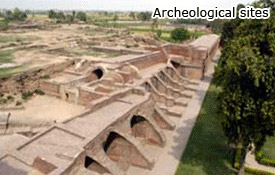 |
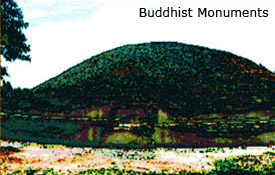 |
|
| |
| Sheikh Chehli Mausoleum |
The tomb of Sheikh Chilhi Jalal is a fascinating monument, octagonal in shape, crowned with a dome of white marble and surrounded by a white marble courtyard. Tourists may also check out Chini Masjid and Pathar Masjid, two outstanding monuments built in the Mughal architectural style.
It is a beautiful monument of medieval times. It contains the mortal remains of the great Sufi saint Abudul-Karim popularly known as Sheikh Chehli, who was also the spiritual teacher of the scholar prince Dara Shikoh, son of the Mughal Emperor Shah Jehan.
Built of buff sandstone, the tomb is crowned by a pear shaped dome of marble on a high circular drum. The cenotaph of the revered saint is in the centre of the chamber while the graves rests in the lower. |
|
 |
|
| |
Another tomb of sand stone with a dome of marble decorated with floral designs is situated on the western wall of the enclosure. It is said to be Sheikh Chehli's wife. The beautiful monument resembles the Taj Mahal and in view of its architectural and historical importance, has been declared as a 'protected monument' of national importance by the Archaeological Survey of India.
Haryana's history has been synonymous with religious tolerance and communal harmony. During the Sultanate period, (C-1206-1526 A.D.), Haryana witnessed the growth of Sufism on its soil. The earliest seat of this order in this region-the Chistis, named after its founder, the great Sufi saint Mouiniddin Chisti had its centre at Hansi. Thanesar and Panipat also emerged as important centres of Sufism. |
| |
| Sthaneshvara Mahadev Temple |
Situated on the North side of Thanesar,this temple is dedicated to Lord Shiva.
It can be said without a doubt that the presiding deity of Thanesar is Lord Shiva. It is after the Sthanesvar Shiva Linga Temple that Thanesar gets its name. Vaman Puran categorically mentions the importance of this temple and legends tell us that Lord Brahma Himself laid the first Linga of Lord Shiva at the temple. Renovated in recent times, the temple has a white amla (fruit shaped) dome. A large water body has been designed before the temple.
It was constructed by Raja Pushyanmurty,an ancestor of the emperor Harshvardhana. A Gurudwara that lies opposite the Sthanesvar temple marks the spot sanctified by the visit of Guru Tegh Bahadur. |
|
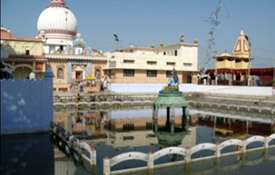 |
|
| |
Ma Bhadra Kali temple |
The famous Ma Bhadra Kali temple celebrates the legend of Sati Mata. It lies a short drive from the Sthanesar Mahadev Temple. The learned say Sati's lower limb fell here, granting the area the sanctity of a Sidh Peethor a place where wishes are fulfilled. The temple has been renovated with red stone and the inner sanctum has been beautified. At a well in the precincts, devotees offer terracotta horses as offerings in thanks-giving, each time their wishes are fulfilled.
The inner sanctum of the temple houses both the awe inspiring and the sublime forms of the Mother Goddess Kali. Thousands of devotee throng the temple on the holy days of Navratre (March-April and September-October) and every year. |
|
|
|
| |
| Ban Ganga |
The legend of the Ban Ganga goes back to the final days of the Mahabharata battle when the patriarch, Bhishma, lay mortally wounded on a bed of arrows. In his dying moments, he felt thirsty and, as the patriarch of both the Kauravas and Pandavas, sent for Arjun. It is said that Arjuna's arrow brought the waters of the holy Ganga to quench the thirst of Bhishma. Today the site is worshipped as Bhishma Kund and lies some 12 km from Kurukshetra. |
|
|
|
| |
| Jyotisar |
Jyotisar, the birth place of the holy scripture Bhagavad Gita, is one of the famous holy centers of Kurukshetra. It is about 12 km from Kurukshetra on the Pehowa road.
Kurukshetra Development Board has renovated the site and a mango shaped lake has been built. Covered bathing ghats, cement parapets, and pavement are also constructed. Flowering bushes and eucalyptus trees enhance the beauty of the area.
Kurukshetra Junction Railway Station is 5 km from Jyotisar.
The sacred spot where Lord Krishna delivered the eternal and timeless sermon of Bhagvad Gita- the song |
|
|
|
celestial. Jyotisar delights with its fine waterbody, bathing ghats and small temples. Here the marble image of Lord Sri Krishna and Arjun stand immortalised in marble: Lord Krishna explaining to Arjun, the doctrine of Karma through the Gita Updesh. A banyan (believed to be an off-shoot of the original tree under which the Lord gave His Sermon) gives shade to the area. One of the most revered placed of Dharama-Kshetra Kuruskhetra is Jyotisar. It is here under the 5000 years old holy banyan tree that Lord Krishna is believed to have delivered the eternal message of Bhagawad Gita to Arjuna before the commencement of the battle of Mahabharata.
The word Jyotisar constitutes of two parts - "Jyoti" meaning light and "Sar" meaning "tank" and "essence". Thus Jyotisar, symbolically signifies the essence of enlightenment. A beautiful marble chariot depicting Lord Krishna delivered the eternal message of Gita to Arjuna, canopied by a Banyan tree exists at the site. There is an old Shiva temple and a Brihm sarover also here.
Recently, a Sound and Light Show, on the theme of Bhagawad Gita has been mounted by ITDC and Haryana Tourism at Jyotisar. This show tries to capture the drama of Mahabharata with special emphasis on the teaching of Bhagawad Gita. |
| |
| Pehowa |
It is an ancient town not far from Kurukshetra has been a centre of pilgrimage for ages. It is on the, left bank of the sacred Saraswati, twelve kilometers from Thanesar. Pehowa was built sometime in ad 882 although an inscription on a temple claims that it was actually built in ad 895. The town derives its name from King Prithu. On the death of his father says a legend, the King sat on the bank of river Saraswati, offering water to all visitors. As a result, the place came to be known as Prithudaka or Prithu's pool. The town which he afterwards built on the spot was called by the same name. With time, the town of Prithu came to be called Pehowa. Today, it is an ancient place of great sanctity, where prayer and `pind daan' for ancestors is believed to grant `moksha' or redemption from the cycle of birth and death.
Pehowa is also famous for temples devoted to Shiva and his son Kartikkya. Unlike the other temples, the temple dedicated to Shiva, has no linga. Instead, it has a panch-mukhi (5 faced) idol of Lord Shiva which is said to be one of its kind. Haryana Tourism runs its Anjan Yatrika Resort for pilgrims visiting Pehowa. |
| |
| Tourist resorts at Kurukshetra |
| Govt of Haryana has constructed many tourist resorts/motels and hotels at Kurukshetra and around where a comfortable stay can be easily arranged. |
|
Sources: Various websites on Kurukshetra, Wikipedia etc. For booking Tourist resorts one may look in to http://kurukshetra.nic.in/tourist |
|




